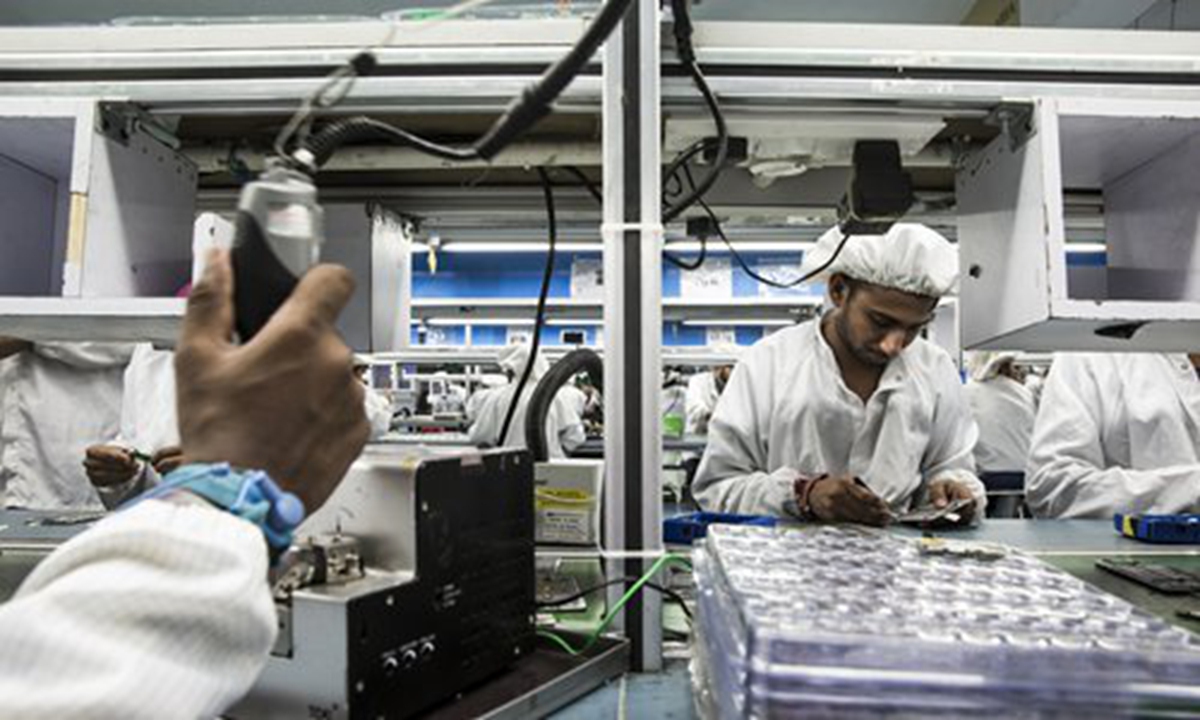
A view of a production line of a smartphone factory in India. File Photo: VCG
In spite of the continuous waves from the COVID-19 pandemic, many still maintain high expectations on the Indian economy as one latest report estimates that the country is likely to surpass Japan to become the second largest economy in Asia-Pacific region by 2030 and the third largest in the world.
Such reports have been made by economic institutes in recent years, with estimations ranging generally from late 2020s to early 2030s. "India's nominal GDP ... is forecast to rise from $2.7 trillion in 2021 to $8.4 trillion by 2030," read the latest estimation conducted by London-based IHS Markit. It means India will exceed Japan, Germany, France and the UK becoming Asia's second largest and the world's third largest economy, according to the report.
As one of the representative emerging markets, the growth of Indian economy has attracted worldwide attention and was even once considered as a possible "second China."
However, after ups and downs in recent years, the Indian economy "becoming the second China" has become increasingly unlikely. Though it recorded rapid growth after the Modi administration took office in 2014, the momentum did not last long and the Indian economy soon entered a gloomy phase since 2017. Besides the slap by the novel coronavirus and following variants, there obviously remain plenty of challenges ahead for the Indian economy if it aims to realize a rosy growth and surpass Japan.
For starters, India has not set up a complete industrial system yet. Its industrialization progress has been lagging behind, compared to most major economies and many Southeast Asian countries. The hysteretic industrialization has led to a weak domestic industrial chain, low productivity and lack of connections between industries among other issues.
After years of the Make-in-India campaign launched by the Modi administration, the proportion of manufacturing value-added in India's GDP even saw a further decline, from 15.58 percent in 2015 to 13.6 percent in 2019, according to an analysis of the China Institute of International Studies.
Moreover, the deeply rooted protectionism has not only limited India's use of foreign investment but, more importantly, has kept it out of the trend of regional integration, which could deliver much more severe consequences for India's long-term development. New Delhi quit the negotiation of the Regional Comprehensive Economic Partnership (RCEP) at the last minute and it seems unlikely to join the Comprehensive Progressive Trans-Pacific Partnership (CPTPP) either.
Both agreements will greatly boost trade liberalization and industrial cooperation among members. As one of the major Asian economies, India will soon feel the pressure of isolating itself from the deals.
Besides India's distance from regional economic agreements, its economic policies toward China has been hijacked by politics in recent years, from attempting to heighten scrutiny over Chinese investment and boycotting products made in China to cracking down on Chinese apps. But the economic complementarities between China and India have been distinctly demonstrated after bilateral trade surpassed the $100 billion milestone in 2021 against the backdrop of the pandemic and New Delhi's hostile policies. India clearly has more to gain by choosing to cooperate with China.
In fact, rather than being reluctant to cooperate economically, India should actively join hands with China in various fields, including trade and industrial connectivity, if it wants to grow into a regional economic powerhouse. By enhancing economic ties with China, India could speed up the paces of regional integration which could in turn enhance its industrialization, create more jobs and boost exports.
Besides isolating itself from regional integration, India is also facing multiple challenges domestically, from poor infrastructure and insufficient skilled labor to unsatisfying business environment. Growing into a leading regional economy is obviously not a simple task for India. New Delhi should roll out genuine and surefooted efforts to tackle challenges and joining regional integration would be a crucial step.
The author is an editor with the Global Times. Bizopinion@globaltimes.com.cn




